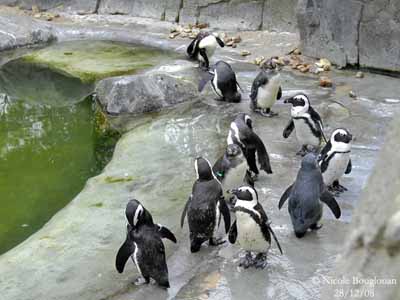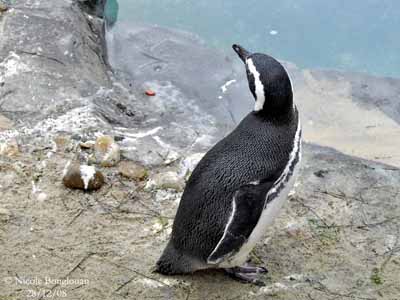
African Penguin
Spheniscus demersus
Sphenisciforme Order – Spheniscidae Family
BIOMETRICS:
Length : 60 à 70 cm
Weight : 2100 à 3700 g
LONGEVITY: Up to 11 years
PROTECTION / THREATS / STATUS:
African Penguin is threatened by oil pollution, over fishing on surrounding waters by humans, reducing their food resources, and predation and competition for breeding sites by seals, sharks and Straw-necked Ibises.
Protection of this species includes nature reserves or national parks where the islands when they breed are situated. But African Penguin is exposed to threats such as terrestrial predators, and diseases such as mosquitoes.
South Africa is very successful in cleaning penguins after oil pollution, and they get a very good survival rate.
Fr: Manchot du Cap
All : Brillenpenguin
Esp : Pingüino de El Cabo
Ital : Pinguino del Capo
Nd : Zwartvoetpingüin
Text and photographs by Nicole Bouglouan
Pictures taken at the Zoo Aquarium of Madrid - Spain
Sources :
HANDBOOK OF THE BIRDS OF THE WORLD vol 1 by Josep del Hoyo-Andrew Elliot-Jordi Sargatal - Lynx Edicions - ISBN: 8487334105
BIRDS OF AFRICA SOUTH OF THE SAHARA by Ian Sinclair and Peter Ryan - Princeton University Press Princeton and Oxford - ISBN: 0691118159
Penguins of the world (Mike Bingham)
Wikipedia (Wikipedia, The Free Encyclopedia)

DESCRIPTION:
African Penguin adult male has black upperparts. Underparts are black and white. We can see a black stripe on the breast, extending down on flanks until vent. Belly is white with some tiny black spots. Wings are black above, and whitish and black below.
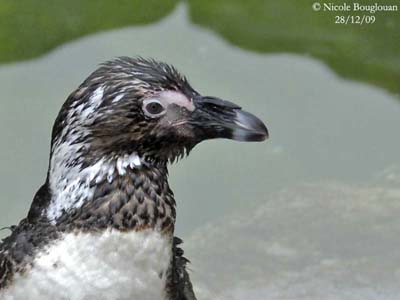
African Penguin has big head with black crown, face, chin and upper throat. A white stripe starts as an eyebrow, from the base of the bill, separating black cheeks and crown, and descending on foreneck and on flanks, until undertail feathers.
Bill is slightly hooked on the top. It is black with pale bend. Eyes are black with pink lores and eye ring.
Black webbed feet show pink splotches and black claws. Black legs are very short.
Female is similar, with shorter bill, and she is smaller than male.
Juvenile varies from greyish-blue to brown above, and lacks the white face pattern and the black breast band. It reaches its sexual maturity at four years of age.
Penguins have dark colour on back and white underparts, in order to help them when they are in the water, hiding them from predators.
Penguins have glossy, waterproof feathers in order to keep their skin dry. These species have more feathers than other birds. At one year, they moult during 3 weeks. They don’t swim during this period, and they can’t eat because they can’t dive without waterproof feathers.
VOICE: SOUNDS BY XENO-CANTO
African Penguin utters a loud, donkey-like braying, mainly at night. They communicate between them by squawking.
HABITAT:
African Penguin lives in warm latitudes. They hunt for food in tropical waters, but they live on rocky shores without vegetation, on in beaches with some plants, where they breed and raise their young.
RANGE:
African Penguin lives only on the coasts of South Africa. They breed under the African sun on numerous islands offshore, between Namibia and Port Elizabeth, in South Africa.
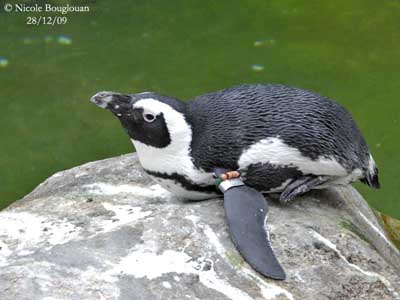
BEHAVIOUR:
African Penguin feeds on fish and crustaceans. It hunts for prey under water, and can reach a top speed of almost 25 km per hour. They have to travel to find food resources. These distances may vary from 30 to 100 km per trip. When they feed their young, they perform more limited distances.
African Penguin may dive during two and half minutes, and about 30 metres in depth, but dives of 130 metres in depth have been observed. They hunt in large flocks of 50 to 100 penguins.
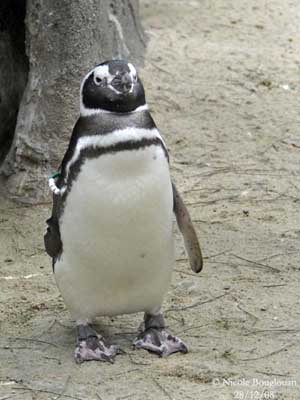
African Penguin has extended breeding season, according to the location of the colonies. They breed in November and December in Namibia and in March to May in South Africa.
They are monogamous and pairs generally return to the same colony and nest site every year. Most of pairs remain together in consecutive breeding seasons, until up to 10 years.
African Penguin moults during about 3 weeks. Before this period, they spend 5 weeks feeding to reach fat deposits. They may lose up to half of their body weight during this moult. When their plumage is complete, they return to sea, spending 6 weeks feeding, fattening up again.
In order to live terrestrial life in temperate areas, African Penguin is more active at dawn and dusk than during the day. They nest in burrows or under bushes to protect from solar radiations. The other birds spend the day at sea or on beaches, but they swim regularly. Birds remaining in the open turn back on sun, in order to expose their darker side.
FLIGHT:
African Penguin does not fly, but it swims up to 7 km per hour, and 25 km per hour when hunting.
REPRODUCTION:
African Penguin nests in colonies on rocky offshore islands. They nest in burrows they excavate themselves, or in depressions under bushes or boulders. Nest site has to be sheltered to provide shade and protection against the temperate climate, but also against egg and chick predators.
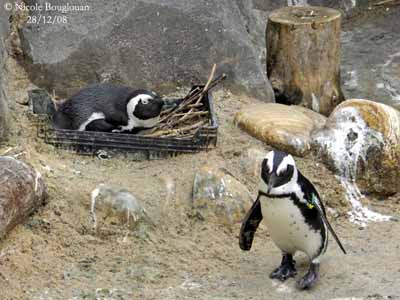
Female lays two eggs. Incubation lasts about 40 days, shared by both male and female. Each parent incubates about two days and half, depending on food resources at the time. Parents may use a piece of skin extending from stomach to cover eggs and provide them warm. Chicks are fed by regurgitation.
Parents brood the chicks for the first 15 days. At this time, chicks reach full control over their body temperature. However, adults survey them from predators for 15 days more, until young are one month old.
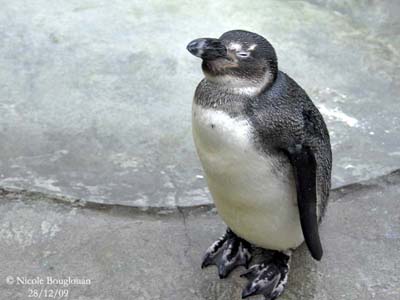
Chicks often form creches when they are left alone, in order to reduce attacks from adults. Young can fledge at any time, from 2 to 4 months of age. It depends of the availability and quality of food.
Young are fed by parents while are present at the colony. But young may leave it without their parents. Then, they remain away from their natal colony from 12 to 22 months, and they return to this colony to moult and reach adult plumage.
DIET:
African Penguin feeds only on marine food. It feeds on fishes, crustaceans and squid.
